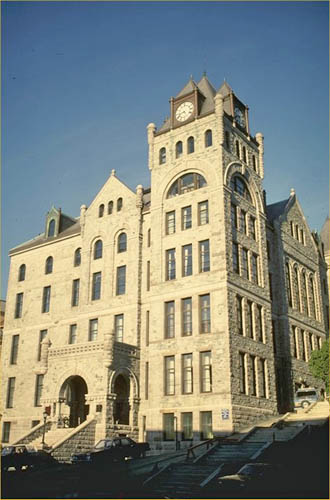St. John's Court House National Historic Site of Canada
St. John's, Newfoundland and Labrador

General view
© Parks Canada | Parcs Canada
Address :
194 Water Street, St. John's, Newfoundland and Labrador
Recognition Statute:
Historic Sites and Monuments Act (R.S.C., 1985, c. H-4)
Designation Date:
1981-01-15
Dates:
-
1900 to 1904
(Construction)
Event, Person, Organization:
-
William H. Greene
(Architect)
Other Name(s):
-
St. John's Court House
(Designation Name)
Plaque(s)
Existing plaque: 194 Water Street, St. John's, Newfoundland and Labrador
The St. John's Court House, built 1900-1904, is by far the most striking and elaborate court house in the province. Set into a steep hill it commands a dramatic view of the harbour. The Romanesque Revival building was designed by W.T. Whiteway and constructed of local sandstone and granite. The site, scale and design all give an impression of solidity and power, considered appropriate for its legal and other functions. The building has housed the supreme court, jail, police court, law library, judges' offices and the Colonial Secretary's office. For a time the legislature also met here.
Description of Historic Place
St. John’s Court House is a imposing, early-20th century, granite and sandstone, Romanesque Revival-style public building, prominently located on the main commercial street of the city of St. John’s, Newfoundland. Its siting on a steep hill overlooking the harbour, permits unhindered views to and from the harbour. The formal recognition consists of the building on its legal property.
Heritage Value
St. John’s Court House was designated a national historic site because it is representative of the judicial institution in Newfoundland; and it is the most striking and elaborate court house in the province.
Built in 1901-04 to replace an earlier courthouse and market on the same site, the St. John’s Courthouse was designed to house the Supreme Court, Police Court, judges’ chambers, law library, and the Colonial Secretary’s office. For a brief time the legislature also met here. It continues to be used as a court house today. Designed by architect William H. Greene, the monumental scale and Romanesque Revival-style design of the building convey an impression of solidity and power appropriate to its legal function. The building’s commanding presence is accented by its dramatic siting on a steep hill overlooking the St. John Harbour. The heavy grandeur of its exterior is matched by the elaborate wood detailing of the interior.
Source: Historic Sites and Monuments Board of Canada, Minute, June 1980.
Character-Defining Elements
Key elements which relate to the heritage value of the St. John’s Court House include:
its Romanesque Revival style, evident in its weighty proportions and rusticated stonework, detailing including arcading, turrels, arched openings, steeply pitched roofs, gabled dormers, prominent towers; Its heavily rusticated stonework with patterned detailing; the three-storey, Duckworth Street facade, characterized by a central projecting bay with arched entrance, a series of blind arches, a square tower at one corner, and a massive round tower at the other; the Water Street elevation, including its six-storey height, massive clock tower, arcading and arched portico with elaborate stone detailing; the Water Street entrance, with its double doors with arched transom, stone staircase, and arched portico with decorative stonework including voussoirs, keystone, columns, balustraded balcony and carved motifs; its construction of local blue siltstone, sandstone, and granite; surviving elements of the original interior plan relating to the administration of justice in the colony, including the main floor rotunda, staircases, courtrooms and offices; surviving, original, interior detailing and fixtures, including dark oak trim, panelling, staircases, doors, courtroom furnishings, and a mosaic-tile floor; its siting on the steep grade of Market House Hill, allowing it to rise three storeys on the Duckworth Street elevation and six storeys on the Water Street elevation viewscapes to and from the building and St. John’s Harbour.